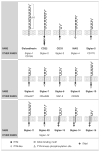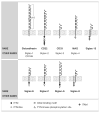Basic and clinical immunology of Siglecs
- PMID: 19076345
- PMCID: PMC3902170
- DOI: 10.1196/annals.1443.011
Basic and clinical immunology of Siglecs
Abstract
Siglecs are cell-surface proteins found primarily on hematopoietic cells. By definition, they are members of the immunoglobulin gene super-family and bind sialic acid. Most contain cytoplasmic tyrosine motifs implicated in cell signaling. This review will first summarize characteristics common and unique to Siglecs, followed by a discussion of each human Siglec in numerical order, mentioning in turn its closest murine ortholog or paralog. Each section will describe its pattern of cellular expression, latest known immune functions, ligands, and signaling pathways, with the focus being predominantly on CD33-related Siglecs. Potential clinical and therapeutic implications of each Siglec will also be covered.
Conflict of interest statement
Dr. Bochner is a co-author on existing and pending Siglec-8-related patents. If Siglec-8-related products are developed in the future, under a licensing agreement between Glaxo-SmithKline and the Johns Hopkins University, Dr. Bochner may be entitled to a share of royalties received by the University on the potential sales of such products. The terms of this arrangement are being managed by the Johns Hopkins University in accordance with its conflict of interest policies.
Figures



References
-
- Crocker PR, et al. Siglecs: a family sialic-acid binding lectins. Glycobiology. 1998;8:v–vi. - PubMed
-
- Varki A, Angata T. Siglecs – the major subfamily of I-type lectins. Glycobiology. 2006;16:1R–27R. - PubMed
-
- Brinkman-Van der Linden EC, et al. Human-specific expression of Siglec-6 in the placenta. Glycobiology. 2007;17:922–931. - PubMed
-
- Angata T, Varki NM, Varki A. A second uniquely human mutation affecting sialic acid biology. J Biol Chem. 2001;276:40282–40287. - PubMed
Publication types
MeSH terms
Substances
Grants and funding
LinkOut - more resources
Full Text Sources
Other Literature Sources

